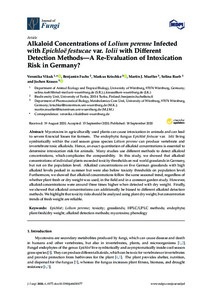Alkaloid Concentrations of Lolium perenne Infected with Epichloë festucae var. lolii with Different Detection Methods—A Re-Evaluation of Intoxication Risk in Germany?
Fuchs B; Mueller MJ; Rueb S; Krauss J; Vikuk V; Krischke M
https://urn.fi/URN:NBN:fi-fe2021042822621
Tiivistelmä
Mycotoxins in agriculturally used plants can cause intoxication in
animals and can lead to severe financial losses for farmers. The
endophytic fungus Epichloë festucae var. lolii living symbiotically within the cool season grass species Lolium perenne
can produce vertebrate and invertebrate toxic alkaloids. Hence, an
exact quantitation of alkaloid concentrations is essential to determine
intoxication risk for animals. Many studies use different methods to
detect alkaloid concentrations, which complicates the comparability. In
this study, we showed that alkaloid concentrations of individual plants
exceeded toxicity thresholds on real world grasslands in Germany, but
not on the population level. Alkaloid concentrations on five German
grasslands with high alkaloid levels peaked in summer but were also
below toxicity thresholds on population level. Furthermore, we showed
that alkaloid concentrations follow the same seasonal trend, regardless
of whether plant fresh or dry weight was used, in the field and in a
common garden study. However, alkaloid concentrations were around three
times higher when detected with dry weight. Finally, we showed that
alkaloid concentrations can additionally be biased to different alkaloid
detection methods. We highlight that toxicity risks should be analyzed
using plant dry weight, but concentration trends of fresh weight are
reliable.
Kokoelmat
- Rinnakkaistallenteet [19207]
